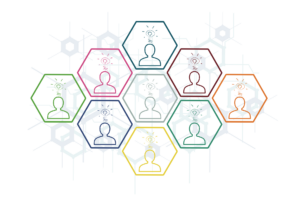For instance, McKinsey & Company’s analysis, in its blog, “What it takes to rewire a CPG company to outcompete in digital and AI,” highlights a notable disparity: “CPG companies are among the poorest performers in digital and AI maturity, while retailers are near the top.”
This underutilization of AI and ML can be attributed to several factors, including outdated organizational structures, insufficient investment in digital transformation, and a lack of requisite skills within the workforce. To bridge this gap and fully harness the potential of AI and ML, CPG companies need to make strategic changes in their approach.
Current Challenges in AI and ML Adoption
Several key challenges impede the effective adoption of AI and ML within many organizations. Here are some of the most common ones:
- Siloed Implementations: Many CPG companies have implemented AI and ML in isolated pockets of their operations rather than across the entire organization. This fragmented approach limits the technologies’ potential benefits because the full value of AI and ML is realized only when these systems are integrated across multiple functions and processes. Without a unified strategy, companies miss out on synergies that could enhance efficiency and innovation.
- Legacy Systems: A significant barrier is the reliance on outdated enterprise resource planning (ERP) systems and other legacy technologies. These systems often impede the seamless integration of new technologies, causing delays in digital transformation initiatives. The challenge lies in modernizing these systems without disrupting ongoing operations.
- Skill Gaps: The deployment and management of AI and ML systems require specialized skills that are currently in short supply. Many CPG companies struggle to find and retain talent proficient in data science, machine learning, and related fields. This shortage not only hampers implementation but also affects the company’s ability to innovate and stay competitive.
- Inadequate Data Management: Successful digital transformation relies heavily on the quality and accessibility of data. Many CPG companies face issues with fragmented and inconsistent data, which complicates the extraction of actionable insights and the making of informed, data-driven decisions. Effective data management is crucial for maximizing the impact of AI and ML technologies.
Investing in AI and ML Organizations
To address these challenges and maximize ROI from AI and ML investments, CPG companies should focus on several key areas of organizational transformation:
- Leadership Roles: Introducing roles such as Chief AI Officer (CAIO), Chief Digital Officer (CDO), and Chief Growth Officer (CGO) can provide the necessary leadership and strategic direction for digital initiatives. These roles are critical for bridging the gap between technology and business functions. Leaders in these positions should have a robust background in both technology and business strategy, ensuring that digital initiatives align with overall business objectives. These roles can be newly created or replace existing positions, depending on the organization’s needs.
- Skill Development and Talent Acquisition: Addressing the skills gap involves both upskilling existing employees and recruiting new talent with the required expertise. Strategies to close this gap include investing in continuous learning programs, partnering with educational institutions, and implementing reverse mentoring. Reverse mentoring allows younger, tech-savvy employees to share their knowledge with senior leaders, fostering a culture of continuous learning and innovation.
- Create Centers of Excellence: Establishing internal centers of excellence dedicated to digital transformation can provide specialized support for the successful integration of AI and ML. These centers should focus on developing and disseminating best practices, offering training and development programs, and ensuring consistent implementation across the organization. Centers of excellence act as hubs of expertise, driving innovation and maintaining high standards for digital initiatives.
- Modernize IT Infrastructure: Upgrading legacy systems and adopting flexible, cloud-based solutions can significantly improve data management and facilitate the integration of AI and ML technologies. This modernization should be part of a comprehensive digital transformation strategy that aligns with both immediate and long-term business goals. Cloud-based solutions offer scalability and flexibility, enabling companies to adapt quickly to changing technological and market conditions.
- Partnerships with Other Organizations: Forming strategic partnerships with technology providers, startups, and academic institutions can accelerate AI and ML adoption. Collaborations with tech companies can provide access to cutting-edge tools and expertise, while partnerships with startups can offer innovative solutions and fresh perspectives. Engaging with academic institutions can help bridge the skills gap by facilitating research and offering training programs. These partnerships can enhance capabilities, share risks, and foster innovation through combined expertise and resources.
Shifting the Perspective on AI and ML
For CPG companies, leveraging AI and ML for substantial ROI involves more than mere technology adoption; it requires a fundamental shift in organizational roles, responsibilities, and talent management practices.
By creating specialized leadership roles, investing in skill development and talent acquisition, modernizing IT infrastructure, and forming strategic partnerships, companies can unlock the full potential of these technologies. This strategic transformation not only enhances operational efficiency and fosters innovation but also ensures that CPG companies remain competitive in an increasingly digital marketplace.
By addressing these challenges and focusing on these areas of transformation, CPG companies can move beyond their current limitations and begin to realize the transformative benefits of AI and ML. Ultimately, this will drive greater value for their businesses and deliver enhanced outcomes for their customers.
Click here for more columns by Gail Martino; if you enjoy this content, please consider connecting with Gail Martino on LinkedIn.
Contributor
-

Gail Martino, Ph.D is a thought leader and global innovation leader in the fast-moving consumer goods industry, having worked with billion-dollar brands at Unilever and previously at Gillette. With a background spanning both corporate and academic roles, Gail has a proven track record in developing and executing highly effective innovation ecosystems, driving value through strategic partnerships and internal product development. Notably, she has been a valued member of the advisory board for the Front End of Innovation conference since 2015.
View all posts

























































































































































